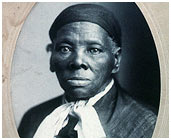Harriet Tubman was one of the selfless individuals who worked towards the abolishment of slavery. Check out the biography, profile and facts on Harriot Tubman.
Harriet Tubman
Date of Birth: 1820

Birth Place: Dorchester County, Maryland
Nationality: African-American
Career: Underground Railroad Operator, Abolitionist, Civil War Spy, Nurse and Suffragist
Harriet Tubman was a true humanitarian, who fought fiercely against the system of slavery. An African-American, she was born into slavery and after escaping from the wretched life, worked tirelessly to obtain freedom, equality and justice for others like her. She made thirteen missions through the Underground Railroad and rescued over 300 slaves. Harriot Tubman was an Underground Railroad Operator, Abolitionist, Civil War Spy, Nurse and Suffragist. Today, she is counted amongst most famous historical figures of America.
Her Life
Harriet Tubman was born as Araminta, or ‘Minty’ in the year 1820, on the plantation of Anthony Thompson, south of Madison in Dorchester County, Maryland. She was the fifth child of Benjamin Ross and Harriet "Rit" Greene, both of whom were slaves. Rit and her children got owned by Edward Brodess, the stepson of Anthony Thompson, through his mother Mary Pattison Brodess Thompson. Edward took Rit and her then five children, including Harriet, to his own farm in Bucktown.
It was here that Harriet’s family got fragmented, when Edward sold her family illegally to out-of-state buyers. It was in the year 1834, when Harriet was only 14, that she first helped a slave escape and in the process, got badly hit on the head by an overseer. In 1844, she married John Tubman, a local free black man, and adopted the name of Harriet. In the 1849, the year Edward Brodess died; Harriet found an Underground Railroad and ran away to Philadelphia. From then onwards started her mission to rescue other slaves through the railroad!
Till 1860, Harriet had made around 13 escape missions and rescued over 300 slaves, including her parents, sister, brother-in-law and her sister’s kids. Throughout her life, she received the support of many black & white abolitionists, who funded her missions. She met John Brown, the legendary freedom fighter, in 1858 and agreed to accompany him on his planned raid at Harper's Ferry, Va. Harriet purchased a home on the outskirts of Auburn (New York) in 1859, where she ultimately settled her aged parents and other family members.
She helped Charles Nalle escape from the custody of United States Marshals in 1860. Harriet joined Northern abolitionists in 1862, in support of Union activities at Port Royal, South Carolina. Apart from being a nurse, she also did spying and scouting behind Confederate lines. When she guided Col. James Montgomery and his regiment up the Combahee River, she became the first woman to command an armed military raid. With the end of the Civil War, she returned to Auburn, New York.
With this started her new life as a community activist, humanitarian, and suffragist. Harriet received recognition in 1869, when Sarah Bradford published ‘Scenes in the Life of Harriot Tubman’, a short biography on her life. Along with fame, she also received financial help from the publication. She married Nelson Davis, a veteran, the same year. Harriet opened ‘Harriet Tubman Home for the Aged’ in Auburn in the later years and transferred it to the African Methodist Episcopal Zion Church in 1903. Harriet left for the holy abode on 10th March 1913, 25 years after she lost Nelson Davis (1888).
Harriet Tubman Timeline
- 1820 - Born in Dorchester County, Maryland
- 1826 - Rented out for the first time, by Brodas, to Mrs. James Cook
- 1831 - Heard the first story about the Underground Railroad
- 1834 - Hit in the head by overseer, while helping a slave escape
- 1844 - Married John Tubman
- 1849 - Ran away from the Brodas plantation
- Worked in a hotel in Philadelphia
- 1850 - Made her first trip to rescue her sister, brother-in-law and their two children
- 1851 - Crossed border for the first time and went to Canada
- 1852 - Made her second trip on the Underground Railroad to rescue her brother and two other men, discovered her husband’s infidelity
- 1857 - Rescued her mother and father through the Underground Railroad
- 1858 - Met Captain John Brown
- 1860 - Rescued around 70 slaves through the Underground Railroad
- Spoke at New England Antislavery Conference, as Moses
- 1861 - Met Charles Nalle
- Made her last trip to Maryland
- 1862 - Headed to Port Royal on the recommendation of Governor Andrews
- 1863 - Accompanied Colonel Montgomery in the Combahee River raid
- 1865 - Returned to Auburn
- 1867 - John Tubman died
- 1869 - "Scenes in the Life of Harriet Tubman" by Sara Bradford published
- 1869 - Married Mr. Nelson Davis
- 1886 - “Harriet, the Moses of Her People” by Sara Bradford published
- 1888 - Nelson Davis died
- 1896 - Spoke at a meeting of the National Federation of African-American Women
- 1903 - Gave her home and land over to the African Methodist Episcopal Zion Church in Auburn, New York
- 1913 - Died on 10th March
More from iloveindia.com
- Home Remedies | Ayurveda | Vastu | Yoga | Feng Shui | Tattoos | Fitness | Garden | Nutrition | Parenting | Bikes | Cars | Baby Care | Indian Weddings | Festivals | Party ideas | Horoscope 2015 | Pets | Finance | Figures of Speech | Hotels in India : Delhi | Hyderabad | Chennai | Mumbai | Kolkata | Bangalore | Ahmedabad | Jaipur
- Contact Us Careers Disclaimer Privacy Policy Advertise With Us Lifestyle Sitemap Copyright iloveindia.com. All Rights Reserved.







